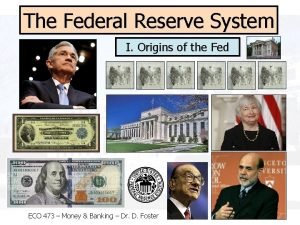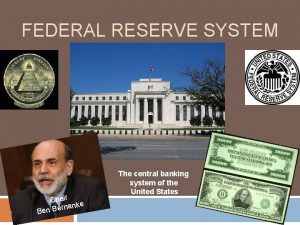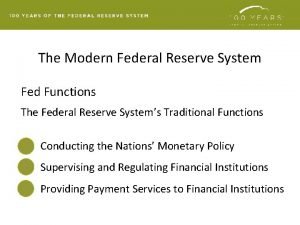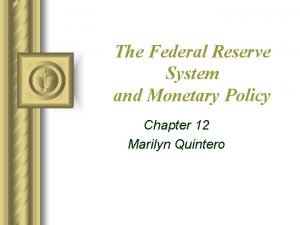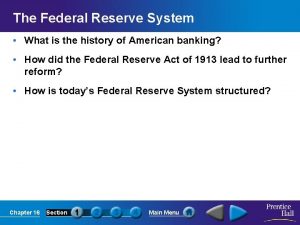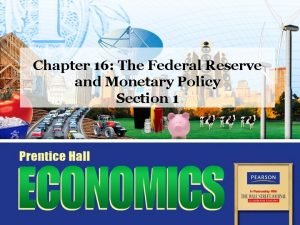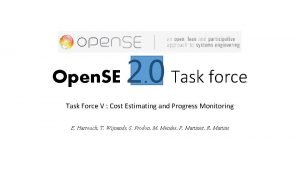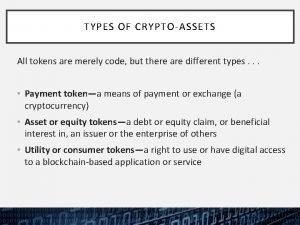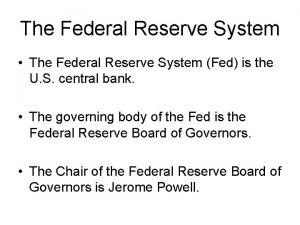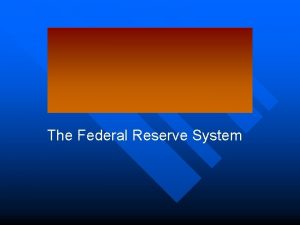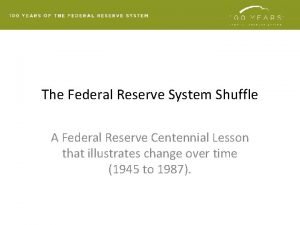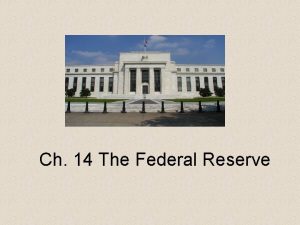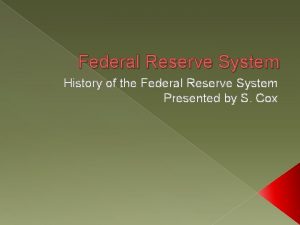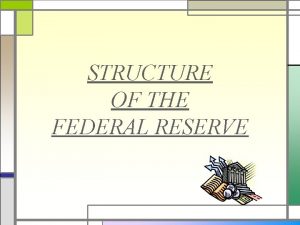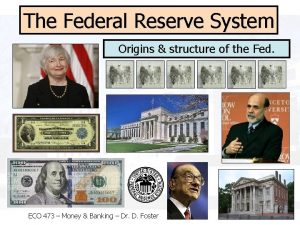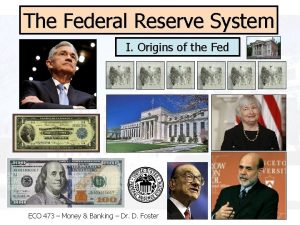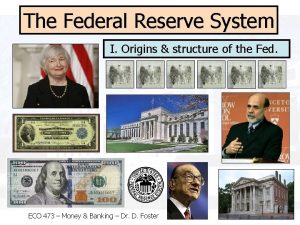The Federal Reserve System I Origins of the












- Slides: 12

The Federal Reserve System I. Origins of the Fed ECO 473 – Money & Banking – Dr. D. Foster

Central Banking - The 1 st and 2 nd BUS • Mercantilist movement behind banks. • Fed owns 20%, deposits funds here. • Banks buy government debt; issue notes. • 1791 -1796 wholesale prices up 72%. • Periodic specie suspension and bank panics. • BUS will hold bank notes. • 2 nd BUS inflates, then deflates in 1819. • “The bank was saved, but the people ruined. ” • Jackson kills the 2 nd BUS.

The “Free Banking” Era: 1836 -1863 • Van Buren sets up Independent Treasury System – Came and went and lasted only until Civil War. – Fed’l government held only specie, not paper. • Decentralized banking 1836 -1862 – Still heavily regulated. – State banks required to hold state gov’t. debt to back their note/dd issue. – Notes accepted for taxes. – Restricted branching making redemption harder. • Private note clearing – Suffolk System – Held specie reserve of members. – Different bank notes accepted. – Insulated banks from panics.

Evolution to Central Banking: 1865– 1912 v The National Banking Act (1863) v The Gold Standard (1875). v Brief foray into bi-metalism. v Panics of 1873, 1893 and 1907 v Federal Reserve Act of 1913

The National Banking System • The National Banking Act of 1863 – Created nationally-chartered banks. – Created a national currency. – Taxed non-national bank notes. – Bought gov’t debt & issued notes. – The rise & fall of Jay Cooke. – State banks still benefit by holding reserves in nat’l notes. – Didn’t stop periodic panics.

The Federal Reserve System • “An engine of inflation. ” • An addition layer means more money creation. • 1914 to 1920, MS doubles – member banks DD 250%. – non-member banks DD 33%. • Reserve deposits on savings falls. – Shift from DD to TD. – Generally accepted that savings are “payable upon demand. ” • Ben Strong & the Morgans.

The Federal Reserve Banking System v Purpose: Purpose 1. Develop, supervise & control the nation’s money. 2. Serve as a national check-clearing system. 3. Serve as depository for federal gov’t. funds. v Board of Governors of the FRS ü 7 members, equal standing. . . but, includes ü Secretary of the Treasury and ü Comptroller of the Currency. v Problems: Problems ü Only using discount window, ü Each District Bank sets its own policy.

The Federal Reserve Banking System

The Early Fed, 1913– 1935 v Accommodates the Treasury Dept. during WWI. ü Buys Treasury bonds to finance G spending (aka “monetizing the debt”). ü From 1916 to 1918, this increases MS by 70%. ü Huge risk of inflation. v The Great Depression - Failure of the Fed ü Initially increased liquidity, but pulled back. ü By 1933, 33% of banks fail, MS fallen 33%.

The Fed - version 2. 0, 1935 v Serves as a “lender of last resort. ” v Board of Governors reconstituted: ü All 7 member selected by President/Senate confirms. üCan’t include Treasury Sec. nor Comptroller of Currency. ü Members serve 14 yr. terms on staggered basis. ü Geographic diversity. ü Office of Chairman and Vice Chairman created. ü Has authority over district banks. v Federal Open Market Committee (FOMC) ü 12 members; primary policy-making body.

The Evolution of the Modern Fed v WWII - working “for” the U. S. Treasury v Federal Reserve–Treasury Accord (1951) v “Leaning Against The Wind” – Martin (1953 -1970) v The technocratic Fed – Burns (1970 -1978). . . the “political business cycle” v Coping with inflation – Volcker (1979 -1987) v Keeping the economy stable? – Greenspan (1987 -2006) v Coping with recession – Bernanke (2006 -2014) – Yellen (2014 -? )

The Federal Reserve System I. Origins of the Fed ECO 473 – Money & Banking – Dr. D. Foster
 Who created the federal reserve
Who created the federal reserve Fractional reserve system
Fractional reserve system Federal reserve system
Federal reserve system Federal reserve functions
Federal reserve functions Three parts of the federal reserve system
Three parts of the federal reserve system Ferderal reserve
Ferderal reserve Federal reserve system pyramid
Federal reserve system pyramid The federal reserve system is overseen by the
The federal reserve system is overseen by the The federal reserve system worksheet answers
The federal reserve system worksheet answers Difference between capital reserve and reserve capital
Difference between capital reserve and reserve capital Contingency reserve vs management reserve
Contingency reserve vs management reserve Difference between capital reserve and reserve capital
Difference between capital reserve and reserve capital Federal reserve jurisdiction
Federal reserve jurisdiction
